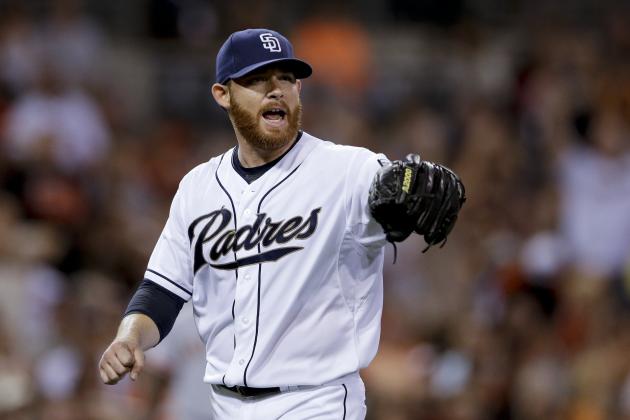Draft Pick Compensation Continues to Throw Wrench in MLB Free Agency – Bleacher Report

Back in November, it seemed the San Diego Padres were taking a risk when they offered $15.8 million to pitcher Ian Kennedy. It seemed like Kennedy was taking just as big a risk when he turned it down.
Seriously, $15.8 million for one year, for a guy who lost 15 games and served up home runs at a higher rate than any other full-time major league starting pitcher? Seriously, he thought he was going to do better than that, especially after the Padres’ offer guaranteed he would cost the signing team a draft pick?
Seriously, he did. Saturday, Kennedy agreed to terms on a five-year, $70 million contract with the Kansas City Royals.
As Fox Sports’ Ken Rosenthal tweeted:
#Royals would not be thrilled about giving up their first-round pick, but they need a starter to help defend their World Series title.
— Ken Rosenthal (@Ken_Rosenthal) January 13, 2016
Remember that when someone tells you baseball’s qualifying-offer system for free agents is broken. But also remember this: Of the six best free agents who remain unsigned, five are tied to draft picks. So if you (or I, or owners) want to bring up Ian Kennedy as proof that the system works, someone else (or agents) can point to Ian Desmond as proof that maybe it doesn’t.
Desmond, a shortstop who turned down that $15.8 million qualifying offer from the Washington Nationals, remains unsigned. Meanwhile, teams like the New York Mets and San Diego Padres turned to free-agent shortstops who didn’t require them to forfeit a draft pick.
Desmond is a long way from becoming Stephen Drew, another shortstop who was weighed down by a draft pick in the winter of 2013-14. Drew went through the entire baseball winter unsigned, finally going back to the Boston Red Sox on May 21.
But as the winter goes on and spring training approaches and Desmond, Justin Upton, Yovani Gallardo, Dexter Fowler and Howie Kendrick remain unsigned, the question of whether the system works will get more and more attention—and the possibility that it becomes a bigger part of negotiations for a new collective bargaining agreement will only increase.
For now, the Major League Baseball Players Association prefers not to comment. But at the very least, the union is certain to want to see the system at least tweaked in the next CBA.

Alex Brandon/Associated Press/Associated Press
The way it works now, teams can give qualifying offers to any of their free agents who spent the entire season with the same club. The amount of the offer is adjusted annually by averaging the top 125 player salaries from the previous season. Players who accept the offer are considered signed. Players who reject become free agents, with a team that signs them forfeiting a draft pick and the team that loses them gaining one.
The idea was to make the offer amount high enough to only cover players who would be worth giving up a draft pick to sign. But as the game has gotten younger and talent has become harder to acquire, the value of those draft picks has continued to rise. Now, even big-market teams like the Los Angeles Dodgers and New York Yankees hate surrendering picks.
“If you’re picking in the top 15 or 20, it’s different than picking 50,” Yankees CEO Hal Steinbrenner told reporters, including Ken Davidoff of the New York Post. “We all know that.”
Did his father know that? Did he care?
Anyway, the idea was to make the offer amount high enough that teams wouldn’t just give it to anybody. In the first three years the system was in place, only 34 total qualifying offers were made, and none were accepted. Only three of those 34 players (Drew, Kendrys Morales and Nelson Cruz, all in 2014) ended up signing for less than the qualifying offer.
The offer amount rose from $15.3 million to $15.8 million for this winter, but teams still offered a record 20 players. For the first time, three of those players (Colby Rasmus, Matt Wieters and Brett Anderson) accepted, and another (Marco Estrada) quickly agreed to a two-year, $26 million deal.
For most of the other 16, the draft pick didn’t seem to be any drag on value. Zack Greinke signed for an even higher average annual value than David Price, even though the Arizona Diamondbacks had to surrender a draft pick for Greinke and the Boston Red Sox did not for Price (because he was traded at midseason).

LM Otero/Associated Press
Other players also got huge deals, but a few still don’t have any deal at all. That group includes Yoenis Cespedes, who isn’t tied to a draft pick (because of his midseason trade), but also the five qualifying offer leftovers.
The union may argue the offer amount needs to go up, or that it shouldn’t be limited to a one-year deal. The union could also argue that while teams losing a player should be compensated with a draft pick, the signing team shouldn’t surrender one.
The owners could argue that players like Desmond, who was coming off a poor season, may have simply made a bad business decision by rejecting the $15.8 million.
Or maybe there won’t be any need to argue. Maybe sometime between now and spring training, Desmond and the others will get contracts for much more than $15.8 million, just as Kennedy did.
Seriously, don’t you think that’s possible?
Danny Knobler covers Major League Baseball as a national columnist for Bleacher Report.
Follow Danny on Twitter and talk baseball.
This entry passed through the Full-Text RSS service – if this is your content and you’re reading it on someone else’s site, please read the FAQ at fivefilters.org/content-only/faq.php#publishers.